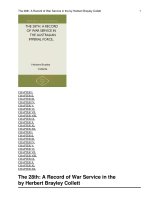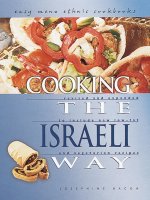- Trang chủ >>
- Đại cương >>
- Kinh tế vĩ mô
cooking the australian way
Bạn đang xem bản rút gọn của tài liệu. Xem và tải ngay bản đầy đủ của tài liệu tại đây (5.3 MB, 74 trang )
easy menu ethnic cookbooks
Cooking
revised and expanded
the
the
to include new low-fat
AUSTRALIAN
and vegetarian recipes
way
way
E L I Z A B E T H G E R M A I N E & A N N L . B U R C K H A R D T
Cooking
the
Austr alian
way
Disclaimer:
Some images in the original version of this book are not
available for inclusion in the eBook.
Copyright © 2004 by Lerner Publications Company
All rights reserved. International copyright secured. No part
of this book may be reproduced, stored in a retrieval system,
or transmitted in any form or by any means—electronic,
mechanical, photocopying, recording, or otherwise—with-
out the prior written permission of Lerner Publications
Company, except for the inclusion of brief quotations in an
acknowledged review.
Lerner Publications Company
A division of Lerner Publishing Group
241 First Avenue North
Minneapolis, MN 55401 U.S.A.
Website address: www.lernerbooks.com
Library of Congress Cataloging-in-Publication Data
Germaine, Elizabeth.
Cooking the Australian way / Elizabeth Germaine & Ann L.
Burckhardt.—Rev. and expanded.
p. cm. — (Easy menu ethnic cookbooks)
Includes index.
Summary: An introduction to the cooking of Australia, featuring such
recipes as egg and bacon pie, Anzac biscuits, pumpkin soup, and glazed
kiwi tart. Also includes information on the history, geography, customs
and people of the “land down under.”
eISBN: 0–8225–1697–7
1. Cookery, Australian—Juvenile literature. 2. Australia—Social life and
customs—Juvenile literature. [1. Cookery, Australian. 2. Australia—Social
life and customs.] I. Burckhardt, Ann, 1933– II. Title. III. Series.
TX725.A9 G47 2004
641.5994—dc21 2002153396
Manufactured in the United States of America
1 2 3 4 5 6 – JR – 09 08 07 06 05 04
easy menu ethnic cookbooks
Elizabeth Germaine & Ann L. Burckhardt
a
•
the
way
revised and expanded
to include new low-fat
and vegetarian recipes
Lerner Publications Company Minneapolis
Cooking
AUSTRALIAN
Contents
AN AUSTRALIAN
AFTERNOON TEA, 37
INTRODUCTION, 7
The Land, 8
The History, 10
The Food, 12
Holidays and Festivals, 15
BEFORE YOU BEGIN, 19
The Careful Cook, 20
Cooking Utensils, 21
Cooking Terms, 21
Special Ingredients, 22
Healthy and Low-Fat Cooking Tips, 24
Metric Conversions Chart, 25
TABLE, 27
An Australian Menu, 28
LUNCH, 31
Egg and Bacon Pie, 32
Fresh Fruit Salad, 33
Pineapple Fruit Cup, 34
Te a , 3 8
Tomato and Mint Sandwiches, 39
Anzac Biscuits, 41
DINNER, 43
Creamy Pumpkin Soup, 44
Crunchy Fish Fillets, 46
Beef Curry, 48
Sunshine Salad with Vinaigrette
Dressing, 51
DESSERTS, 53
Glazed Kiwi Tart, 54
Lamingtons, 55
Bread and Butter Custard, 57
HOLIDAY AND FESTIVAL
FOOD, 59
Roast Leg of Lamb, 60
Roast Vegetables, 61
Rich Gravy, 62
Mint Sauce, 63
Damper, 64
Pavlova, 66
Macadamia Nut Bread, 69
INDEX, 70
When man
y people think of Australia, they picture a colorful, wild
land full of dangerous crocodiles, cuddly koalas, and daring adven-
turers. In fact, Australia is a country of many different lifestyles and
climates, ranging from the desolate outback—where neighbors live
very far apart—to crowded coastal cities such as Sydney and
Melbourne. In the tropical north, people can wear shorts year-
round, while in the colder south they sometimes get the chance to
ski on snowcapped mountains.
Australian cooking reflects this variety. It combines the foods of
Britain—the homeland of Australian colonists—with foods brought
by southern European immigrants and, more recently, by immi-
grants from neighboring countries near the Pacific Ocean. Creative
Australian cooks adapt the ever-widening range of influences and
fresh produce to their busy schedules.
Austr
alia’s British heritage is reflected in the custom of serving afternoon tea.Tomato
and mint sandwiches are often served at teatime. (Recipe on page 39.)
7
Darwin
INDIAN OCEAN
G
R
E
A
T
D
I
V
I
D
I
N
G
R
A
N
G
E
AUSTRALIA
Meekatharra
Innamincka
BUNYA
Brisbane
MOUNTAINS
PACIFIC
OCEAN
Sydney
Perth
Wagga Wagga
Canberra
Melbourne
INDIAN OCEAN
ASMANIAT
The Land
Australia, the world’s biggest island and smallest continent, is called
“down under” because it lies entirely within the Southern
Hemisphere—south of the equator. Australia also includes the island
of Tasmania, which lies south of Melbourne. The waters of the
Indian and Pacific Oceans lap Australia’s shores. The island of New
Guinea lies to the north, and New Zealand is to the southeast.
Australia is part of the group of countries called the Pacific Rim.
8
This island continent covers nearly three million square miles, rough-
ly the size of the mainland United States. Australia is home to 19.7 mil-
lion people, who are nicknamed Aussies.The nation’s capital is Canberra.
A sparsely populated desert occupies the central part of this vast
land, and the mountains of the Great Dividing Range run down the
eastern coast. Bustling cities and sparkling beaches line the eastern,
southeastern, and extreme southwestern coasts. Fertile farms and
large ranches, called stations, lie in the nation’s rural areas.
Because Australia lies in the Southern Hemisphere, its seasons are
the reverse of those in the Northern Hemisphere. The coolest win-
ter months are between June and August, while summer’s heat lasts
from December to February. In general, Australia has a warm, dry,
pleasant climate, but the climate varies from one part of the country
to another. Tourists generally visit the hot, tropical northern areas
during the dry winter season. Rain comes to the north during the
hot summer months—and when it rains, it pours.The climate of the
southeast is milder, and most of the region’s rain falls during the
winter months. Although it does not snow in any of the large south-
eastern cities, snow does fall in the nearby mountains.
In addition to having a variety of climates, Australia is also home
to some very unique wildlife. For example, the kangaroo and the
koala are marsupials—mammals that give birth to helpless offspring
Image Not Available
9
that mature in a pouch on their mother’s abdomen. Other native ani-
mals include the emu (an ostrichlike, flightless bird), the duck-billed
platypus, and the laughing kookaburra bird with its unique call. The
kangaroo and the emu are depicted on the national coat of arms.
The History
Place names such as Meekatharra, Innamincka, Oodnadatta, and
Wagga Wagga dot the Australian map. These colorful names were
used by the aborigines, nomadic people who have inhabited
Australia for at least forty thousand years. An important part of the
aborigines’ culture is the idea of the Dreamtime. Aborigines
believe that the first beings on earth lived during the Dreamtime.
According to aboriginal legends, these first inhabitants were
spirits who created natural wonders such as fire, rain, and land
formations. The Dreamtime spirits told tales that guided daily life,
from fishing and hunting to finding shelter. From these stories, the
aborigines learned how to live in Australia’s environment, which
was very dry and sometimes harsh.
Modern Australian history dates to January 1788, when Europeans
first landed just north of Botany Bay—later named Sydney Harbor. At
that time, Britain imprisoned many people for fairly minor crimes,
such as being unable to pay debts. As a result, British prisons were
badly overcrowded. To solve the problem, the British government
created a colony in Australia. About seven hundred prisoners and two
hundred British soldiers—some with wives and children—estab-
lished the first European settlement in what became the city of
Sydney.
These colonists survived with basic supplies and food staples from
Britain, supplemented by the food they found around them—fish,
wild fruits, and nuts. But living conditions were harsh.The Australian
climate was hot and dry compared to the cool, rainy British Isles.
The Irish potato famine, a crop failure that began in 1845 and
10
Image Not Available
during which thousands of Irish people starved to death or fled
Ireland, prompted a flood of Irish immigration to Australia. In 1851,
when gold was discovered in southern Australia, thousands more
immigrants from various nations headed to the island. Many
prospectors who did not find gold stayed in Australia, bought plots
of land, and became farmers. After World War II (1939–1945), large
numbers of Italians, Greeks, and other Europeans moved down
under. Later, many families from Southeast Asia arrived to work and
live in Australia.
11
Because of Australia’s historic ties to Britain, Australian culture
shares similarities with British culture. Many Aussies have a special
affection for Britain.
But this connection with Britain meant that, for a long time,
Australians did not have a national identity of their own. They
bought goods and borrowed customs from other countries,
chiefly Britain and the United States. Over the years, however,
Aussies have gradually developed a sense of national pride in their
unique island home.
The Food
The aborigines were experts at using the fresh, natural foods of their
native land. Fruits, seeds, nuts, vegetables, and flower nectars all had
their places on aboriginal menus, alongside seafood, meat such as
kangaroo or possum, and various insects.
Later, rural Australians—who were known as bushmen because
they lived in the Australian wilderness, which is also known as the
outback or the bush—ate hearty, simple food that they called
“tucker.” Bushmen usually carried a tucker bag containing some
flour, from which they made a simple bread called damper. Though
damper was nothing but a flour-and-water dough cooked on a
stick held over the campfire or baked in the ashes, to hungry bush-
men, it was delicious.
Modern Australian cooking is built on a solid foundation of
British cooking, part of the island-nation’s colonial heritage. At
one time, meat was the mainstay of the down-under diet. Because
of the many ranches in Australia, meat was plentiful and excellent.
Most families ate meat and potatoes at nearly every meal. Cooks
usually served mutton (sheep meat) or lamb and sometimes beef
or pork.
Two foods that most Australians love are meat pies and Vegemite.
Meat pies—pastry crusts filled with meat and gravy—are tasty but
12
high-fat snacks. Vegemite, on the other hand, is very healthy. A
salty, black yeast extract, Vegemite is rich in vitamins and minerals.
Aussies enjoy it spread ever-so-thinly on bread, toast, or rusks
(very dry, crispy pieces of bread), and it is often one of a child’s
first solid foods.
But Australian cuisine has expanded beyond these traditional
favorites. Since World War II, Australia has welcomed many immi-
grants. As a result of the multicultural influences of new ethnic
groups, Australian menus have become more diverse. Italians and
Greeks introduced squid and mussels, new vegetables, and various
herbs. European cheese makers brought with them methods of mak-
ing a wide range of fine cheeses from cow and goat milk.Vietnamese
and Chinese immigrants introduced stir-fries and sold special ingre-
dients such as ginger, vegetables, greens, and hot peppers.
Image Not Available
13
Image Not Available
No matter what the style of cooking, seafood that has been freshly
caught along Australia’s long shoreline is superb. Diners can select
prawns (large shrimp), lobsters, scallops, or fillets from dozens of
species of fish.
Fruits and vegetables arrive fresh in Aussie kitchens, too.The pop-
ulous southeast corner of the country contains many orchards, vine-
yards, and farm gardens. Australian cooks also enjoy preparing baked
goods, and they often use hearty whole-grain flours for their breads
and sweets.
14
Holidays and Festivals
Just as Australian cooking is a combination of tradition and experi-
ment, holidays in Australia bring together new and old customs.
Before the arrival of Europeans, Australia’s aborigines had their own
set of beliefs and rituals. Later, most of the British colonists and set-
tlers were Christian, and the majority of modern-day Australians fol-
low one of the branches of Christianity. For them, Christmas, on
December 25, is one of the year’s biggest holidays.
Because Australia lies in the Southern Hemisphere, Christmas falls
right in the middle of summer. Kids are on a six-week vacation, the
beaches are packed, and many people are busy shopping for holiday
gifts and making preparations. Although some families have
Christmas trees, wintry decorations such as pine boughs and holly
are often replaced by native Australian plants. Christmas bells, a
brightly colored flower with bell-shaped blossoms, and branches of
the Christmas bush, a flowering tree, adorn many Australian homes.
On Christmas Eve, the pleasant weather allows Melbourne residents
to hold the Carols by Candlelight celebration outdoors. For more
than sixty years, Aussies of every age have gathered to sing Christmas
carols at this annual event.
Christmas Day is usually hot in Australia—temperatures sometimes
soar higher than 100°F. Even in such steamy weather, some
Australians prepare traditional Christmas dinners, often heavily influ-
enced by British custom. These dinners include dishes such as roast
turkey, ham, potatoes with gravy, and cooked vegetables. However,
many people have adopted newer, more summery traditions, and
Christmas picnics and backyard barbecues are popular. Cold roasts,
such as turkey, ham, or roast beef, or grilled foods, such as fish,
shrimp, chicken, or vegetables, accompany salads and fruit dishes.
Desserts are also a must, with favorites including light, airy pavlova—
a meringue pastry topped with fresh fruit and whipped cream—
Christmas pudding, shortbread, and bonbons.
After dinner, children and their families enjoy trips to the seaside
15
or to the park to play with new toys and to visit with friends.
December 26, which is the national holiday Boxing Day, gives
people a chance to relax and clean up after the festivities.
Another big day is January 26, Australia Day. This holiday com-
memorates the official founding of a British colony in Australia.
Throughout the nation, parades, fireworks, live entertainment, and
craft fairs celebrate Australian history and culture. In Sydney, hungry
revelers can get their fill at the Great Australian Bite, a giant food fes-
tival. Many cities and towns hold community breakfasts, serving up
bacon, eggs, and pancakes to get the day off to a good start. Events
such as log-chopping contests and campfire cooking competitions
test Australians’ skills in the outback.
Not long after Australia Day, an event with even older roots takes
place in the Bunya Mountains, located northwest of the eastern
city of Brisbane. Australia’s aboriginal residents hold many cere-
monies and rituals, called corroborees. Most of these occasions are
very sacred, and their details are kept private within individual
aboriginal communities. However, aborigines from many different
groups shared the ancient Bunya Festival. Long before the British
colonists arrived, aborigines from around the region met in the
Bunya Mountains every few years to enjoy corroborees and feasts.
The festival took place in late January or early February, during the
harvest season of bunya nuts. Bunya nuts are large seeds produced
by the bunya pine trees that flourish in the mountains, and festi-
valgoers sampled various dishes prepared with the nuts. In recent
years, the Bunya Festival has been revived and celebrated in
modern Australia.
Another unique Australian celebration is shearing time. Each
September—early spring in Australia—the many sheep raised on
Australian farms and ranches get their annual haircut. Their wool is
sheared off and used to make clothing and other goods. When the
shearing—which often takes several days—is finished, rural families
celebrate with a big picnic by the billabong, a waterhole formed by
a river or creek. Kids swim in the cool water, while adults tend the
16
Image Not Available
cooking fire. The firewood is often eucalyptus, also called gum, or
coolabah.Native to Australia, the wood gives off a nose-tingling aroma
as it burns.
Common dishes at these springtime picnics include grilled lamb
chops, bread and butter, salad, and three or four kinds of biscuits
and cakes. As the sun sets after the evening picnic, full, tired diners
listen to the black-crested cockatoos calling overhead and the kook-
aburras laughing in the trees. Shearing time in the outback is a truly
Australian experience.
17
A
ustralian cooking makes use of some ingredients that you may not
know. Sometimes special cookware is used, too, although the recipes
in this book can be prepared with ordinary utensils and pans.
The most important thing you need to know before you start is
how to be a careful cook. On the following page, you’ll find a few
rules that will make your cooking experience safe, fun, and easy.
Next, take a look at the “dictionary” of utensils, terms, and special
ingredients. You may also want to read the list of tips on preparing
healthy, low-fat meals.
When you’ve picked out a recipe to try, read through it from
beginning to end. Now you are ready to shop for ingredients and to
organize the cookware you will need. Once you have assembled
everything, you’re ready to begin cooking.
P
avlova, a popular Australian dessert, can be topped with fruits that grow in Australia,
such as kiwifruit, strawberries, or bananas. (Recipe on pages 66–67.)
19
The Careful Cook
Whenever you cook, there are certain safety rules you must
always keep in mind. Even experienced cooks follow these rules
when they are in the kitchen.
• Always wash your hands before handling food. Thoroughly
wash all raw vegetables and fruits to remove dirt, chemicals,
and insecticides. Wash uncooked poultry, fish, and meat under
cold water.
• Use a cutting board when cutting up vegetables and fruits.
Don’t cut them up in your hand! And be sure to cut in a
direction away from you and your fingers.
• Long hair or loose clothing can easily catch fire if brought
near the burners of a stove. If you have long hair, tie it back
before you start cooking.
• Turn all pot handles toward the back of the stove so that you
will not catch your sleeves or jewelry on them. This is
especially important when younger brothers and sisters are
around. They could easily knock off a pot and get burned.
• Always use a pot holder to steady hot pots or to take pans out
of the oven. Don’t use a wet cloth on a hot pan because the
steam it produces could burn you.
• Lift the lid of a steaming pot with the opening away from you
so that you will not get burned.
• If you get burned, hold the burn under cold running water.
Do not put grease or butter on it. Cold water helps to take the
heat out, but grease or butter will only keep it in.
• If grease or cooking oil catches fire, throw baking soda or salt
at the bottom of the flame to put it out. (Water will not put
out a grease fire.) Call for help, and try to turn all the stove
burners to “off.”
20
Cooking Utensils
electric mixer—An appliance, either freestanding or handheld, used for
mixing and beating
food processor—An electric appliance with a container and rotating blade
to chop, mix, and blend food
kitchen parchment paper—A nonstick pan liner
kitchen shears—Scissors designed especially to snip herbs and cut a wide
variety of other foods
meat thermometer—A thermometer that is inserted into meat or poultry to
check how well-done the meat is. Some meat thermometers are left
in the whole time the meat cooks, while others are used at intervals.
paring knife—A small knife used for removing pits and cores from fruit
and for peeling vegetables and fruit
pastry brush—A small brush used for coating food or cooking equip-
ment with melted butter or other liquids
rack—A metal frame on which meat is placed for roasting
rolling pin—A cylinder, often of wood, used for rolling out pastry or dough
serrated knife—A knife with a notched or grooved cutting edge
spatula—A flat, thin utensil used to lift, toss, turn, or scoop up food
tongs—A utensil, shaped either like tweezers or scissors with flat, blunt
ends, used to grasp food
wire rack—An open wire stand on which hot food is cooled
wire wisk—A utensil used for beating food by hand
Cooking Terms
beat—To stir rapidly in a circular motion
boil—To heat a liquid over high heat until bubbles form and rise
rapidly to the surface
21
chop—To cut into small pieces
core—To remove the seeds or pit from the center of a fruit or vegetable
cut in—To mix butter or margarine into flour with a pastry blender or
two knives until it has a coarse, mealy texture
dollop—A small amount, about a teaspoonful, of a semiliquid ingredi-
ent such as whipped cream
fillet—A boneless piece of fish or meat
garnish—To decorate a dish with small pieces of food, such as parsley
sprigs
mince—To chop food into very small pieces
pinch—A very small amount, usually what you can pick up between
your thumb and first finger
roast—To cook in an open pan in an oven
sift—To put an ingredient, such as powdered sugar, through a sifter
to break up any lumps
simmer—To cook over low heat in liquid kept just below boiling point.
Bubbles will occasionally rise to the surface.
whip—To beat ingredients at a high speed until mixture is light and fluffy
Special Ingredients
chutney—A thick sauce made from fruit, spices, and vinegar or lemon juice
cinnamon—A spice made from the bark of a tree in the laurel family.
Cinnamon is available ground or in sticks.
curry powder—A blend of six or more herbs, seeds, and spices that gives
food a spicy flavor and a yellow hue
dry mustard—A powder made from the ground seeds of the mustard
plant that is used to flavor food
22
garlic—A bulbous herb whose distinctive flavor is used in many
dishes. Each piece or bulb can be broken up into several small
sections called cloves. Before chopping a clove of garlic, remove
its papery skin.
gingerroot—The knobby, light brown root of a tropical plant, used to fla-
vor food. To use fresh gingerroot, slice off the amount called for,
peel off the skin with the side of a spoon, and grate the flesh. Freeze
the rest of the root for future use. Fresh ginger has a very zippy taste,
so use it sparingly. (Do not substitute dried ground ginger in a
recipe calling for fresh ginger, as the taste is very different.)
kiwifruit—A small oval fruit with fuzzy brown skin and bright green
flesh marked with a circle of tiny black seeds
mint—The leaves of any of a variety of mint plants, used fresh or dried
in cooking
nutmeg—A fragrant spice, either whole or ground, that is often used in
desserts
olive oil—An oil made from pressed olives that is used in cooking and
for dressing salads
parsley—A green, leafy herb used as a seasoning and as a garnish
parsnip—A white root vegetable with a mild, slightly sweet, nutty flavor
passion fruit—A small, egg-shaped fruit with a hard purple shell pro-
tecting yellow-orange pulp, which has a tart-sweet flavor. It is more
readily available canned than fresh in the United States.
rosemary—An herb in the mint family. Rosemary’s needlelike leaves
have a strong flavor and are used as a seasoning and as a garnish.
self-rising flour—Flour which already has baking powder and salt added
to it. Australian cooks often use self-rising flour for convenience.
thyme—A fragrant herb used fresh or dry to season foods
wine vinegar—Vinegar made from red or white wine. Wine vinegars
usually have a sharp, tangy flavor.
23









![economic modeling of water[electronic resource] the australian cge experience](https://media.store123doc.com/images/document/14/y/kr/medium_krl1401382233.jpg)